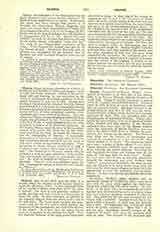

Chancel, part of the choir near the altar of a church, where the deacons or sub-deacons stand to assist the officiating priest. It was originally railed off by cancelli or lattice work, from which the name is derived. The term is now generally confined to parish churches, and such as have no aisles or chapels round the choir. In some churches, in addition to the principal chancel, there are others at the ends of the side-aisles. The Latin word cancellus was commonly used for the low screen which marked the separation of the presbyterium and choir from the rest of the church. In a later time the name chancel came to be applied to the presbyterium itself. Very few chancels, however, of the early period have been preserved in place. A clear idea of the normal arrangement can be had in St. Clement’s at Rome, where the sixth-century screens of the choir and presbyterium were simply removed from the lower church and set up in the twelfth-century church above. In St. Clement’s the chancel screen of the presbyterium coincided with the chord of the apse, and the altar also stood upon this line; the approaches had therefore to be constructed on either side of the altar. The chancels of the presbyterium are surmounted by a light colonnade for the support of curtains. The term was used in England before the Reformation, and the Anglicans still retain it. Among English Catholics it is now little used, that portion of the church near the altar, separated by rails from the nave, being designated the sanctuary. In cathedrals and conventual churches, where space is required to accommodate the canons or the religious, a portion of the church between the sanctuary and the nave is taken for the purpose; it is not, however, called the chancel, but the choir.
THOMAS H. POOLE

